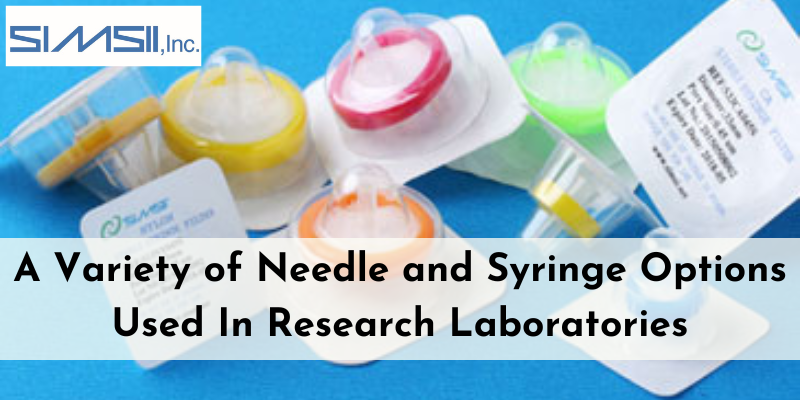
Many medical and scientific applications need the use of needles and syringes. There are many elements to consider, making selecting the appropriate needle and syringe for a given application challenging. In addition to offering advice on how to choose a needle and syringe, this article outlines the key elements to consider. Syringes and needles can be a severe safety risk if not handled properly. Laboratory staff members need to be aware of proper use, safe practices, disposal, and a variety of needle and syringe filter as well as other alternatives to prevent exposure to harmful substances in research labs. Never use needles if there are secure and reliable alternatives.
In analytical, medical, pharmaceutical, or biotechnology applications, syringes use a cylinder and plunger to dispense liquids or gases precisely. An instrument called a syringe injects drugs or other liquids into body tissues or other media. A thin, hollow device called a needle is used to introduce substances into or remove substances from the body parenterally. Needles are frequently included with syringes. However, this is only sometimes the case. Let's understand more about the topic:
Factors to Consider While Selecting a Syringe
Picking any syringe is wrong; you should know the syringe. The syringe series are grouped by application, type, and volume range.
Syringe Types
Identifying your sample type and figuring out the smallest volume that needs to be dispensed or injected are the keys to choosing the best syringe for your application. These are categorized into two types; Microliter (for liquids) and Gastight (for liquids and gases).
Needle Selection
Conical tips penetrate vinyl and polymers, while sharp points are used for HPLC injections. It includes a typical 51 mm (measured in inches at 2 in) needle with the most popular syringe types with the proper gauge and point style. However, we provide many solutions if your project requires a non-standard needle gauge or point style. These are classified into 2 types:
1 Standard needles
2 Custom needles
Terminations
The interface between the syringe and its mating connection, such as the needle, is the termination, which is situated at the end of the syringe barrel. Terminations are available with various needle and connector combinations to suit various applications. However, terminations are classified into the following types:
1 Cemented Needle
2 Luer Tip Cemented Needle
3 Special Cemented
4 Luer Tip
5 Luer Tip Special Cemented Needle
6 Knurled Hub
7 Removable Needle
8 Sample Lock
9 PTFE Luer Lock
Needle Gauge and Length
Consider the needle's dead volume, expressed in L/inch in the gauge index, when selecting a needle gauge to attach to a tiny syringe. It could be challenging to prime the syringe if you choose a needle with an excessively high dead volume. A tiny gauge needle (27–34) can make it difficult to aspirate the sample into the syringe when the sample is to be delivered viscously. Backfilling the syringe can be essential if a small gauge needle is needed. Additionally, slower rates might be necessary to avoid over-pressurizing the syringe.
The syringe's volume and the needle's dead volume should be considered when choosing a needle gauge. For instance, if the dead volume in the needle exceeds 10 L, priming a 10 L syringe will be exceedingly challenging. Before choosing a needle, check the gauge index to select a gauge with the proper L/inch. Choose the shortest length that enables you to complete your application comfortably.
Diameter
A standardized system of gauges is used to3 size the needle's outside diameter. Smaller gauge numbers represent larger diameters. The 14 gauge has the biggest common diameter. 16, 18, and 20 gauge needles are suitable for general lab tasks such as injecting liquids via septa when using short (less than 2 in.) needles. Although thinner needles are available, 24 gauge is generally the thinnest needle.
Syringe Filters
Simple to over-pressurize and prone to popping off or bursting are syringe filters. This has often resulted in splashes to the face in lab settings. The syringe/filter can be held in a closed fist if the material poses a low risk for spills to assist in confining the liquid if the filter comes loose. A more secure connection to the syringe filter can be made using Luer lock syringes. A drastically lowered fume hood sash should be used as splash protection when filtering extremely dangerous compounds. Refrain from using too much pressure if the filter becomes clogged.
Take special care when using tiny syringes, such as those used to administer tuberculin. It is simple to over-pressurize a filter and cause it to rupture or pop off the syringe. It would help if you always remember that pressure equals force times area. The pressure is larger for a given force applied when the syringe diameter is smaller.
Final Words
To ensure patient comfort and safety, healthcare professionals must make a crucial choice about the needles and syringes they use. There are many different types of needles and syringes on the market, each with benefits and drawbacks. Healthcare professionals should choose the needle and syringe that best suits a patient's needs. To be effective look for appropriate needle and syringes accessories including syringe filters, PVDF filter, etc. Before using needles and syringes on patients, healthcare professionals should have adequate training. Patient harm and disease spread can result from improper usage of needles and syringes. Syringes and needles are necessary supplies in the medical field. To ensure the security and comfort of the patient, they must be utilized properly.


